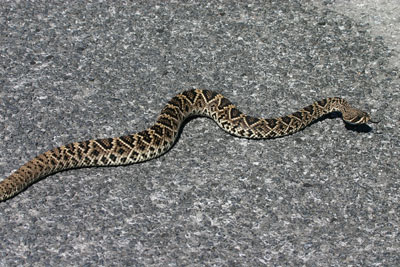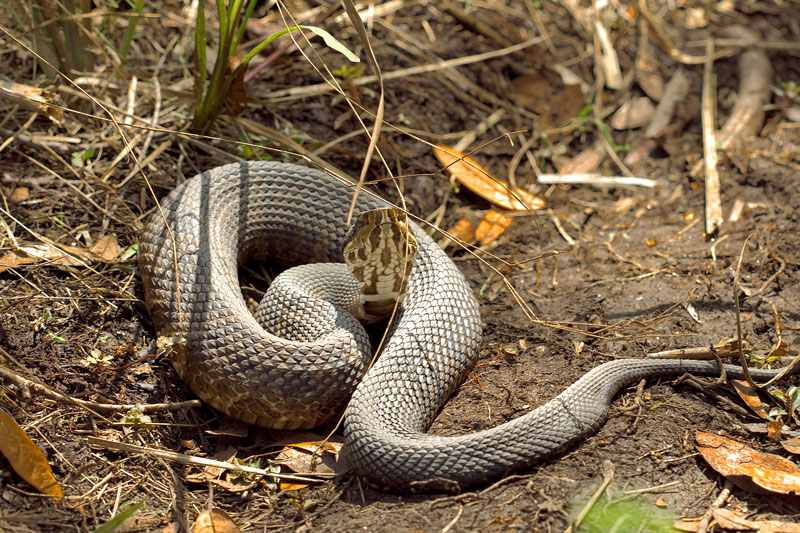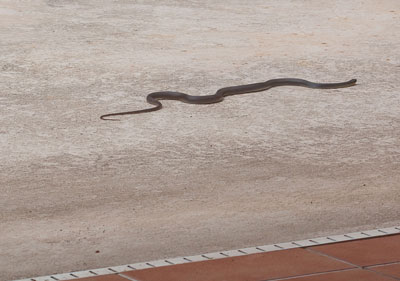What wild things dwell in that uncultivated, unkempt portion of your yard? You know the area I’m talking about — the one where you occasionally dump leaves or hastily pulled weeds, rather than walk around to the compost bin.
Reaching into such areas can yield unexpected, and sometimes unwanted, surprises. I once reached into a thorny area and felt a couple of lit matches against my skin — wasps! Pouring some white vinegar over the stings instantly relieved the pain. But let’s talk about encounters with something many people are inordinately afraid of: snakes.
I like seeing snakes; but I’m also the guy who needed rabies shots from a bat bite. My point: the bat would not have bitten me had I not picked it up off the ground. It’s the same with snakes; if you aren’t a threat, a snake won’t attack you, since you are way too big to be food.
The University of Florida’s Department of Wildlife Ecology and Conservation has identified 46 species of snakes native to Florida; 34 of these can be found in South Florida. Six are venomous, and four of these inhabit South Florida.
 |
| The eastern diamondback |
The eastern diamondback rattlesnake (Crotalus adamanteus) is tough to miss with its pattern of brown/black diamonds outlined in off-white. Its rattle is also a dead giveaway (pun intended). On closer look, it also has what’s called “keeled” scales; instead of being flat, each scale has a raised ridge running down its center, like the keel of a boat. Its venom is the most toxic of any U.S. species. Eastern diamondbacks use their pit organs to sense heat, and will coil, hiss and rattle to warn you off.
The pygmy rattlesnake (Sistrurus miliarius), at about 1 1/2 feet, may seem less frightening, but has a defensive, feisty nature and strikes readily. Its venom is potent, but its diminutive size means it delivers a smaller dose. Gray with black spot-like markings, it is distinguished by an orange stripe down its back; the stripe is interrupted by black splotches. The University of Florida states it is the “most commonly encountered venomous snake in urbanized areas, often in gardens or brush piles.”
The cottonmouth or water moccasin (Agkistrodon piscivorous) prefers basking near the water’s edge but can also be found in pine woods. I almost stepped on one along the Gator Hook Trail in the Big Cypress National Preserve. Adults are dark brown to black and blend in with mud all too well. Juveniles may be much closer to a copperhead in appearance, with splotched bands on a reddish brown body. They don’t readily retreat from a threat.
 |
| A not-so-harmless cottonmouth |
Coral snake (Micrurus fulvius). “Red touch yellow, kill a fellow.” This beautiful snake has many non-venomous mimics, such as the scarlet snake and scarlet kingsnake. If the red bands are touching yellow bands, it’s the coral snake, which unlike its mimics has a black snout. Luckily it is a shy animal, preferring to burrow.
You are very unlikely to meet a venomous snake while gardening. Most snakes encountered while gardening are harmless — actually beneficial — to people. One you’ve probably met is the ringneck snake (Diadophis punctatus). Another burrower, it matures at six to ten inches, and is black with an orange or yellow ring around its neck. Hatchlings easily fit in the palm of your hand. Often found in pools, they are harmless.
Other non-venomous snakes:
Brahminy blind snake (Ramphotyphlops braminus): Sometimes called flowerpot snakes, they look like black earthworms, but are not segmented. Non-native, a burrower and harmless.
The black racer (Coluber constrictor) is very common in suburbs. Ground dwelling, but able to climb, this snake conforms to its name: black and fast. Adults appear uniformly dark, smooth and have a white chin. The lighter gray Everglades racer (Coluber constrictor paludicola) is a subspecies. Though non-venomous, racers will bite in defense. They help by keeping populations of rats, mice, frogs and toads in check — natural pest control.
 |
| A harmless Everglades racer |
Ratsnakes (Elaphe spp) come in red, yellow, gray and many “phases” of appearance. My friend in Homestead recently found one sheltering in her mailbox. They are common and can climb, often spotted in trees. Among the easiest snakes to recognize, they’re another source of rat control.
 |
| Yellow ratsnake—harmless |
There are naturally dozens more, not including non-native introductions like pythons (not venomous, but large examples can be a threat, especially to pets).
If you want to avoid snakes altogether, some tips include keeping grass mowed; sealing gaps around doors, windows, plumbing and vents to keep them outdoors; keeping wood piles off the ground and away from high traffic areas; and eliminating their food source. If you see lots of ratsnakes in your garden, do you have lots of trees dropping fruit and attracting rats? Seeing lots of eastern garter snakes (Thamnophis sirtalis sirtalis)? Do you have a pond loaded with frogs, their favorite food? If you need to work in an overgrown garden area, wear gloves, long pants, a long-sleeved shirt and closed shoes.
A spray from the hose will also chase a snake away, but I encourage you to leave them alone. The chances of encountering a venomous snake are very low, and very few people in the United States (five to six annually) die of a snakebite.
If you’d like to get to know some friendlier garden creatures, visit Fairchild for a nighttime nature walk from 5 to 8 p.m. Friday
|
TREATING A SNAKE BITE In the extremely unlikely event you are bitten by a venomous snake, the Centers for Disease Control advise: • Seek medical attention (dial 911). • Try to remember the color and shape of the snake, which can help with treatment. • Keep still and calm. This can slow down the spread of venom. • If you cannot get to the hospital right away, lie or sit with the bite below the level of the heart. Wash the bite with soap and water. Cover the bite with a clean, dry dressing. WHAT NOT TO DO • Do not pick up the snake or try to trap it. • Don’t wait for symptoms to appear; if bitten, seek immediate medical attention. • Do not apply a tourniquet, slash the wound with a knife, or try to suck out the venom. • Do not apply ice or immerse the wound in water. • Do not drink alcohol as a painkiller.
Learn more about venomous snakes from the CDC:www.cdc.gov/niosh/topics/snakes/ Miami-Dade Fire Rescue Venom Response Program brochure aids snake identification:www.miamidade.gov/fire/library/venomous-snakes-florida.pdf Learn abouToolsMeasureOptionsneral from the University of Florida:http://ufwildlife.ifas.ufl.edu/snakes/south.shtml The Florida Fish and Wildlife Conservation Commission provides a list of handlers who can remove pythons and other wildlife:https://public.myfwc.com/HGM/NWT/NWTSearch.aspx
|
Kenneth Setzer is writer and editor at Fairchild Tropical Botanic Garden
